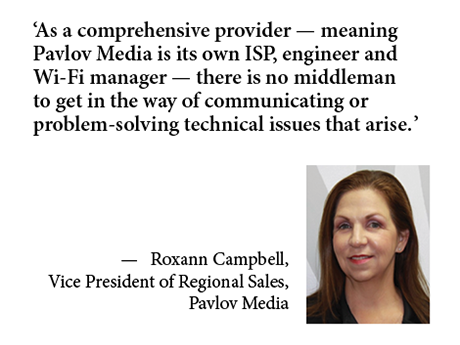“Traditional wired and wireless networks are becoming faster and more reliable with each new standard on the market,” says Pavlov Media CEO Cory Douglas. “We’re seeing multifamily consumers extend these data networks well beyond the need for just for voice and video. There are all kinds of new demands on multi-dwelling units (MDUs) for integrating Internet of Things (IoT), life safety and power and water management systems into traditional data networks.” For more than 30 years, Pavlov Media has been the leading national provider of residential Wi-Fi service, and now, with Douglas as the company’s newly named CEO, Pavlov Media has plans to build on its success through its unique technology and its eye on the innovation required by multifamily’s evolving needs. Douglas, promoted to replace retiring founder and CEO Mark Scifres, says what sets Pavlov Media apart is its ability to rapidly implement broadband Wi-Fi and video solutions for any style of community, located in any part of the country. “That capability is really driven by the investments in our back office, technology and engineering workflows that we’ve developed over time,” Douglas explains. “It’s our goal to make the purchasing and deployment experience easy for our customers. It’s done …
Content Partner
As the pandemic lockdowns hammered offices and retail properties, investors abandoned those assets and plowed cash into apartments and warehouses, both of which witnessed robust rent growth and appreciation as the economy reopened. But in many cases, apartment investors tapped ultra-cheap, variable-rate financing to overpay for multifamily properties, expecting rental rates to continue to climb and help the deals pencil financially. While in large part rents have grown — albeit not at the same double-digit level seen during 2021 and early 2022 — buyers often made the deals with too much optimism and failed to account for potential risks or often, at least, underappreciated them. Now, not only has the debt on those multifamily assets become considerably more expensive in about a year’s time, but labor, insurance, taxes and other operating costs also have increased. As a result, financial cracks are emerging in the multifamily market, says Jeff Salladin, a managing director with Dallas-based private debt fund Revere Capital. What’s more, because of the typical 12-month apartment lease term, landlords are unable to pass those higher expenses onto tenants in a timely fashion, declares Salladin, leader of the firm’s real estate debt team. Even if multifamily owners could increase rents, …
AcquisitionsBuild-to-RentContent PartnerDevelopmentFeaturesLeasing ActivityMidwestNAINortheastSingle-Family RentalSoutheastTexasWestern
Single-Family Rental, Built-to-Rent Investment Sales Outlook Remains Positive Despite Economic Challenges
The multifamily sector is under general disruption from a variety of factors, such as falling valuations, financing difficulties, questions about forward net operating income, shifts in regulations and more. Chris Town, who works in commercial sales and leasing at NAI Latter & Blum in Baton Rouge, La., is an expert in single-family rental (SFR) and built-to-rent (BTR) investment sales. Town says that there are challenges, but a solid future ahead for the sector. The overarching challenges take the form of the Federal Reserve interest rate hikes. “It’s the major factor behind the immediate slowdown of home construction and home buying,” Town explains. “Another factor, of course, is land. These are true whether you’re talking true multifamily or the submarkets of BTR and SFR.” A combination of factors has created a tug-of-war among incentives. High interest rates, with home prices at or near historical highs, mean millions of people need places to live. Many of these potential homeowners have families and want the ameliorations and amenities of a detached single-family housing. “Depending on the metric and organization’s research used, you could say the country is five to six million units short on single-family homes,” Town says. The Larger Economy’s Impact on …
AcquisitionsBuild-to-RentContent PartnerFeaturesLoansMidwestMultifamilyNortheastSingle-Family RentalSoutheastTexasWalker & DunlopWestern
Multifamily Owners Navigate Challenges, Opportunities Arising from Capital Markets
When Zelman & Associates’ 2023 Virtual Housing Summit opens in September, Alex Virtue will take the stage as a newly appointed managing director who has been charged with expanding the firm’s investment banking coverage of multifamily and other commercial real estate property sectors. Virtue joined the institutional research advisory and investment firm in May with over two decades of experience in mergers and acquisition transactions and capital raising across real estate sectors in both the public and private capital markets. His resume includes senior positions with Merrill Lynch, Eastdil Secured/Wells Fargo Securities, CBRE Capital Advisors and Xebec, an industrial developer and asset manager. Zelman & Associates, founded in 2007, was acquired by Bethesda, Md.-based commercial real estate finance and advisory firm Walker & Dunlop in 2021. “My focus at Zelman and Walker & Dunlop is broadening the firm’s reach on entity-level transactions in multifamily and related housing sectors such as single-family rentals, built-for-rent, student housing, affordable housing and manufactured housing communities, as well as other commercial real estate sectors,” says Virtue “I would characterize my concentration as bringing traditional banking investment expertise, knowledge and services across the Walker & Dunlop platform and working with my colleagues to bring these advisory …
BohlerContent PartnerFeaturesIndustrialMidwestMixed-UseMultifamilyNortheastRetailSoutheastTexasWestern
Improved Land Surveys, Due Diligence Can Ensure Development Project Success
Due diligence — particularly land surveying — can be a slow, cumbersome process if a project lacks strong guidelines based on the owner or developer’s particular needs. It can be easy to overprepare for the wrong site or underprepare for the succession of steps needed for the right site. REBusiness spoke to two land surveying experts, Billy Logsdon, divisional director of surveying, and Tom Teabo, associate and regional survey manager. Both work for Bohler, a land development consulting and site design firm, and both have strong insights on how to incorporate each step in the due diligence process elegantly within a well-planned approach. Due diligence such as American Land Title Association (ALTA) surveys and gathering topographic information can be time-consuming and expensive steps — making it beneficial to fit their timing into the larger project in a way that reflects the client’s needs — from the purchase of land to development completion. Logsdon and Teabo highlight the importance of streamlining the survey process and getting owners and developers better results based on their desired outcomes, often starting with the information already available about the site early in the process. REBusiness: What is slowing down survey due diligence, in your experience, and do …
Day-to day life as a property manager in both a conventional multifamily building and student housing can be unpredictable. Hiring and staffing issues can plague many operators, resulting in the need to wear many different hats. These different hats can make it difficult for staff to fully address all of the residents’ needs. Managing a Wi-Fi system — perhaps the most crucial technology platform at any community — is one duty that the onsite team can happily offload to a third-party provider. Reliable Managed Wi-Fi Systems Roxann Campbell, vice president of regional sales at Pavlov Media, says today’s Internet-connected culture has increased the need for residents to have an absolutely reliable managed Wi-Fi system. Pavlov Media (which provides Wi-Fi & fiber services to multifamily and student properties) is an Internet service provider (ISP) that can establish connectivity throughout entire buildings while managing Internet for all of a property’s residents. This managed Wi-Fi approach benefits the buildings’ owner-operators because it offers a planned strategy for wiring and Wi-Fi signals. Routers aren’t competing against each other, as they can in communities that give their residents the option to sign up with any number of competing Internet providers. “Bulk managed Wi-Fi provides residents …
Location’s importance to commercial real estate has become a cliché. But in logistics and industrial considerations, the idea is new again — it’s not about where you are but where customers need to go and the primacy of transportation. If you’re not at the place and time that clients need, it doesn’t matter how theoretically fine the setting or how impressive the facilities are. “Transportation is roughly 12 times the cost of industrial real estate,” says Adam Roth, executive vice president at NAI Hiffman. Finished products, goods and materials are sent into and out of facilities over and over again. Shipping and trucking are a stiffly recurring expense and a much higher spend than real estate. “If I can impact your transportation spend, the real estate is a much smaller factor in the supply chain. If you can address the current concern of transportation, real estate rates almost doesn’t matter, due to a location’s supply chain advantages. Real estate can be one of the best ways to combat transportation costs.” The Rule of 1.5 In practical terms, customers’ plans for transportation are a series of changes, starting at factories, going to ports or warehouses for inventory, on to major and …
Affordable HousingContent PartnerDevelopmentFeaturesLoansMidwestMultifamilyNortheastSoutheastTexasWalker & DunlopWestern
Low-Income Housing Tax Credit Industry Adjusts to HUD Curveball on Income Limits
New income limits for low-income and very-low-income housing in 2023 represent a mixed blessing for the industry’s providers, who gain more potential renters but face ubiquitous caps that restrain their ability to adjust rents. The U.S. Department of Housing and Urban Development (HUD) publishes the income limits annually based on changes in each housing area’s median income, and typically places caps on outlier markets to prevent wide year-to-year swings. From 2010 through 2021, about 10 percent of areas were capped each year. Also in that period, the caps predictably checked the increase in an area’s qualifying income levels to no more than double the annual percent change in national median income. HUD published national median income based on three-year-trailing American Community Survey (ACS) data that HUD adjusted forward using the Consumer Price Index (CPI). In 2022, however, HUD omitted the CPI factor and based limits on historical survey data alone, producing lower results for median incomes and a smaller percentage change to be doubled into a cap. Even so, calculated incomes rose significantly, spurring HUD to cap increases in 57 percent of areas. Industry experts had predicted HUD would add the CPI adjustment back into its calculations in 2023, resulting …
Shopping center owners and property managers throughout the United States are exploring opportunities to increase foot traffic by transforming excess parking into restaurants, entertainment venues, neighborhood amenities and even multifamily uses. “In our experience, nearly every shopping center that’s not grocery-anchored is going through a process to reassess the amount of parking they have, the amount of parking they need and alternative ways to develop those parking areas to add value,” says Cornelius Brown, a principal in the Pennsylvania offices of Bohler, a land development consulting and site design firm. With more than 30 offices across the Eastern and Central United States, Bohler has helped many of its clients with parking conversions ranging from single pad site creation to comprehensive, property-wide redevelopment. Municipalities Onboard Landlords have been carving out parcels for standalone retailers, restaurants and other uses for years, but the trend is accelerating as more and more municipalities ease minimum parking requirements. Parking-reduction advocates have argued that offering fewer spaces reduces environmental impacts associated with heat islands and stormwater runoff. Others contend it promotes the use of mass transit and ridesharing, which can reduce vehicle emissions and, in the case of bars and restaurants, may reduce incidents of impaired …
Content PartnerDevelopmentFeaturesIndustrialLeasing ActivityLee & AssociatesLoansMidwestMultifamilyNortheastOfficeRetailSoutheastTexasWestern
Lee & Associates’ Second-Quarter 2023 Economic Review by Sector
Lee & Associates’ newly released 2023 Q2 North America Market Report outlines industrial, office, retail and multifamily outlooks trends in the United States. This sector-based review of commercial real estate trends for the second quarter of the year examines the difficulties facing each property type and where opportunities in the landscape may be emerging. Troubles with absorption dogged each sector, with the exception of retail, throughout the first half of 2023. Scheduled deliveries for industrial, office and multifamily indicate this trend will continue throughout much of the United States for the foreseeable future. Lee & Associates has made the full market report available here (with further breakdowns of factors like vacancy rates, market rents, inventory square footage and cap rates by city). The summaries from each sector below provide high-level considerations of the overall outlook and challenges in the market. Industrial Overview: Industrial Growth on Track for Least Gain in Years In a reversal from the ballooning logistics capacities required during the pandemic, demand for industrial space has slowed across North America. After continuously rebuilding inventories from the fall of 2021 through the third quarter of last year, many retailers and wholesalers are taking a breather, pausing further inventory accumulation out of caution over …











